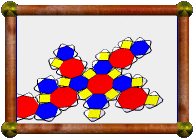


| Home > Gallery > My Models > Cupolae > Crossed Pentagonal Cuploid | |
| Prev (Crossed Pentagrammic Cupola) | Next (Topological Small Stellated Dodecahedron) |
Crossed Pentagonal Cuploid |

The model presented here is a 5/4 cuploid. It's upside-down in this photo with respect to the description above (the 5/4-gon is at the bottom instead of the top). A 5/4-gon is a retrograde pentagon, ie a normal pentagon, but we visit the vertices in the opposite order. The base would be a 10/4-gon, which is two coincident 5/2-gons. These coincident base pentagrams have been removed as described above, but you can see the outline still there, now with triangles meeting squares at these edges instead.
| Home > Gallery > My Models > Cupolae > Crossed Pentagonal Cuploid | |
| Prev (Crossed Pentagrammic Cupola) | Next (Topological Small Stellated Dodecahedron) |